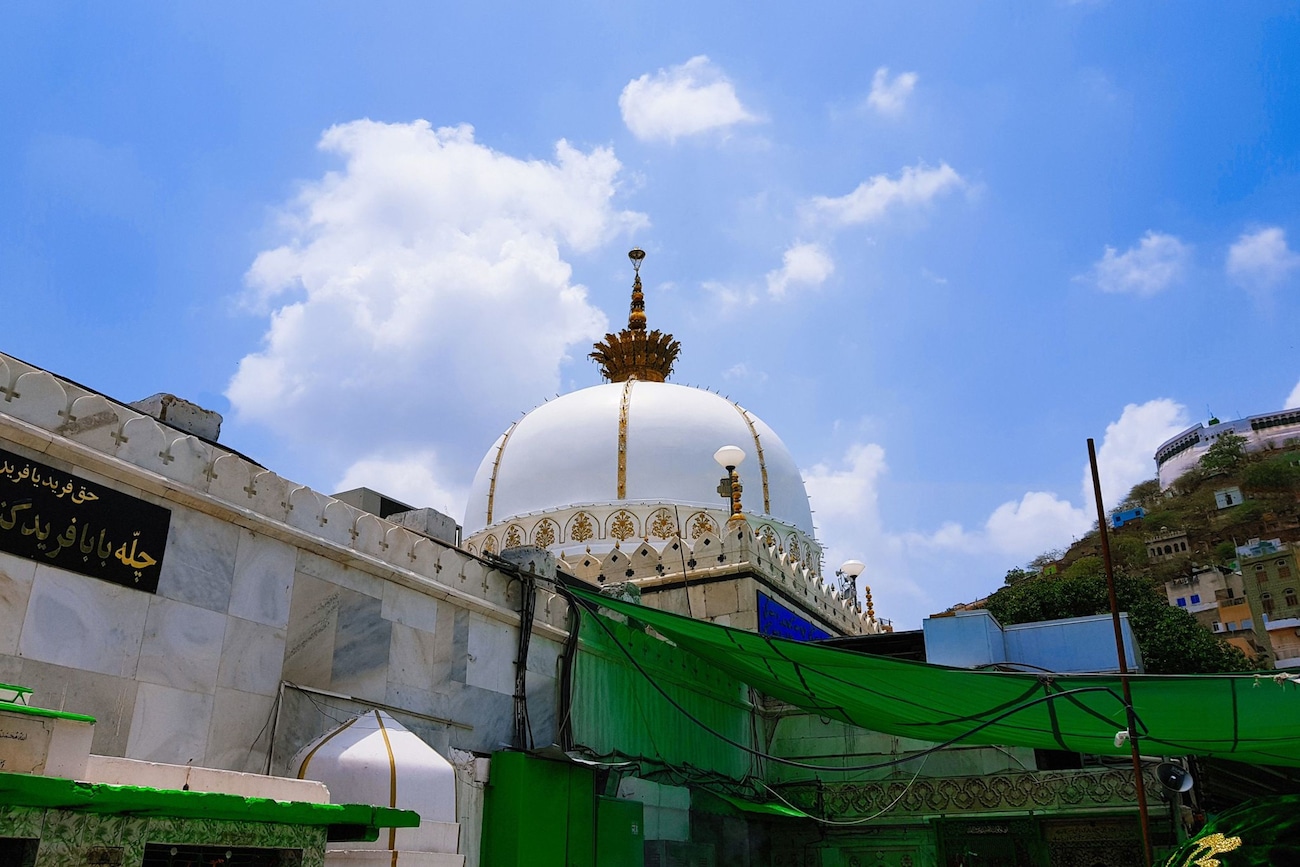Built in 1532, Ajmer Sharif ki Dargah or Dargah Sharif is a fine example of Indo-Islamic architecture. The white marble dome accentuated with a lotus and a crown of gold is Sufi saint Khwājā Moinuddin Chishti or reverently known as Khwājā Ghareeb Nawaz’s shrine. Inside the Ajmer dargah rests the grave of Chishti, a prominent point of interest for pilgrims and tourists all around the world. Accessible to the followers of all faiths and religions, the shrine gained prominence during the Mughal Era.
Apart from Chishti’s maqbara (grave), the complex of Ajmer Sharif dargah is known for its eight entrance gates, out of which only three are in use. The Nizam Gate, a yellow structure with floral motifs is the main gate to enter the Ajmer Sharif dargah complex. An older one, the Shahjahani Gate, defines the expansion of the Ajmer Sharif dargah complex beyond the Buland Darwaza. Other gates are the Madar gate and the Delhi Gate. One is Bihisti Darwaza which is made of silver and is opened during Eid, the annual Urs - the death anniversary of Moinuddin Chishti, and Shawwal - the tenth month of the Islamic calendar.
Along with its majestic architecture, Ajmer Sharif Dargah is one of the most famous dargahs in Ajmer owing to the divine and serene atmosphere it offers, especially during the mehfil-e-samā, a gathering for spiritual Sufi listening which is held during the evening time. Ajmer Dargah is treasured by Sufi music enthusiasts; nothing can be more peaceful than getting lost in the soothing Sufi music while sitting in an environment that is energetic yet peaceful with just the music and its aficionados giving each other company. As the legendary Rumi says, “Music loosen the deafness of spirit. Play and let play”.
1. History of Khwājā Moinuddin Chishti
Also known as Sarkar Khwājā Moin-ud-din Hasan Chishti Ajmeri Urf Khwājā Ghareeb Nawaz (Rehmatullah Alaih), the Sufi saint came to Ajmer in the year 1192 from Persia. He was a preacher, religious scholar, and mystic from the Sistan province of Iran. Chishti was highly influenced by the works of Sunni scholar Khwājā Abdullah Ansari and it was believed that his work on the lives of the early Islamic saints reshaped Chishti’s ideologies and outlook of the world.
Owing to the outstanding works during the Mughal era, Moinuddin Chishti was regarded as a great saint and a charismatic preacher. After he died in 1236, the Ajmer dargah of Khwājā became a revered site for pilgrims and tourists alike.
2. Degh ka Khana
Your visit to Khwājā Moinuddin Chishti’s dargah is incomplete without trying the Langar or Degh ka Khana. Inside the Ajmer dargah, there is a Langar Khana with a Badi Deg which means big cauldron. It was a gift from Mughal Emperor Akbar. And then there’s Choti Degh, a gift from Akbar's son Jehangir. These deghs together feed about 6000 people at a time!
As Khwājā Ghareeb Nawaz has said, “Bhooke Ko Khana Kheelana aur Haajat-Ravai Karna, Acche Nafs Ki Zeenat Hai”. This means feeding the poor and providing for the needy is a marker of a good human being. And that’s exactly what these deghs are used for, feeding the poor and needy, regardless of their religion. This generosity makes Chishti’s dargah one of the best places to visit in Ajmer when you wish to witness humanity at its best.
The food served in the langar is pure vegetarian and the primary ingredients are rice, ghee, cashew nuts, almonds, and raisins. And the taste? A treat for every palate.
3. How to Reach
Counted amongst the most popular tourist sites in Ajmer, Chishti’s dargah is popular for its prominent location. Situated just 2 km from the main central Ajmer Railway station, the location of Ajmer Sharif Dargah is easily accessible. From the station, one can take a cab to the dargah.
4. The Best Time to Visit Ajmer Dargah
Although the best time to visit is September to March, travellers must confirm the opening and closing time of Ajmer Dargah. Gates are open from 5 AM to 9 PM in winters and 4 AM to 10 PM during summers.
The timings may vary during Eid, Urs, and Shawwal. If you book an Ajmer tour package to visit the dargah, do confirm the timings in advance from your tour operating company.
No matter whether you are into Sufism or not. Nothing can beat a calm evening, watching the dervishes swirl on enchanting Sufi music, and in Khwājā Ghareeb Nawaz’s dargah, you get to experience it all.











































Post your Comment
Please let us know your thoughts on this story by leaving a comment.